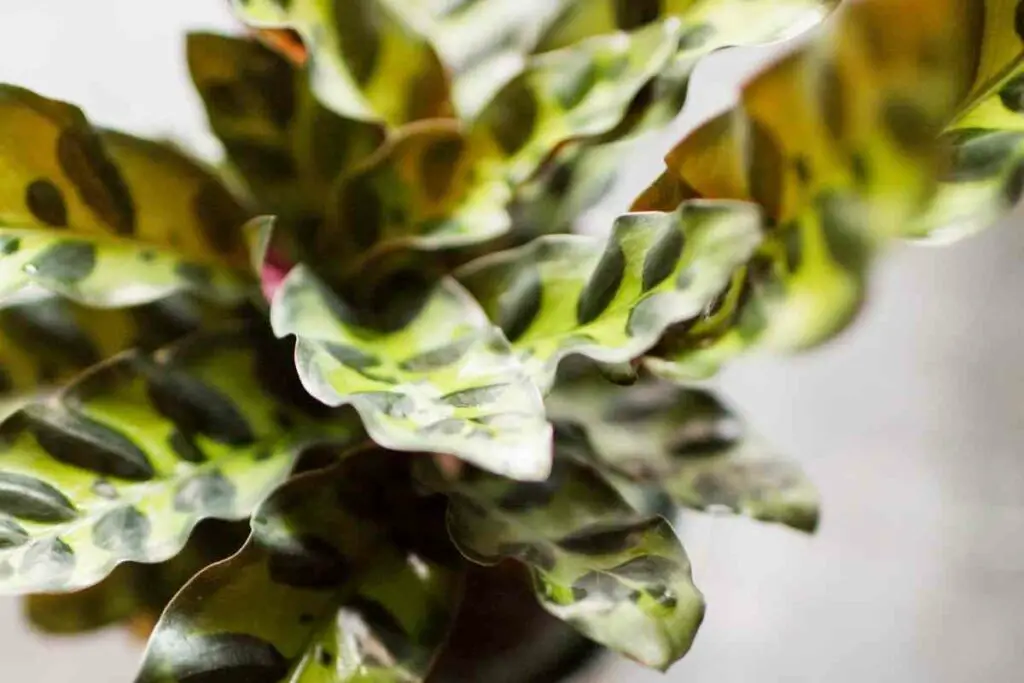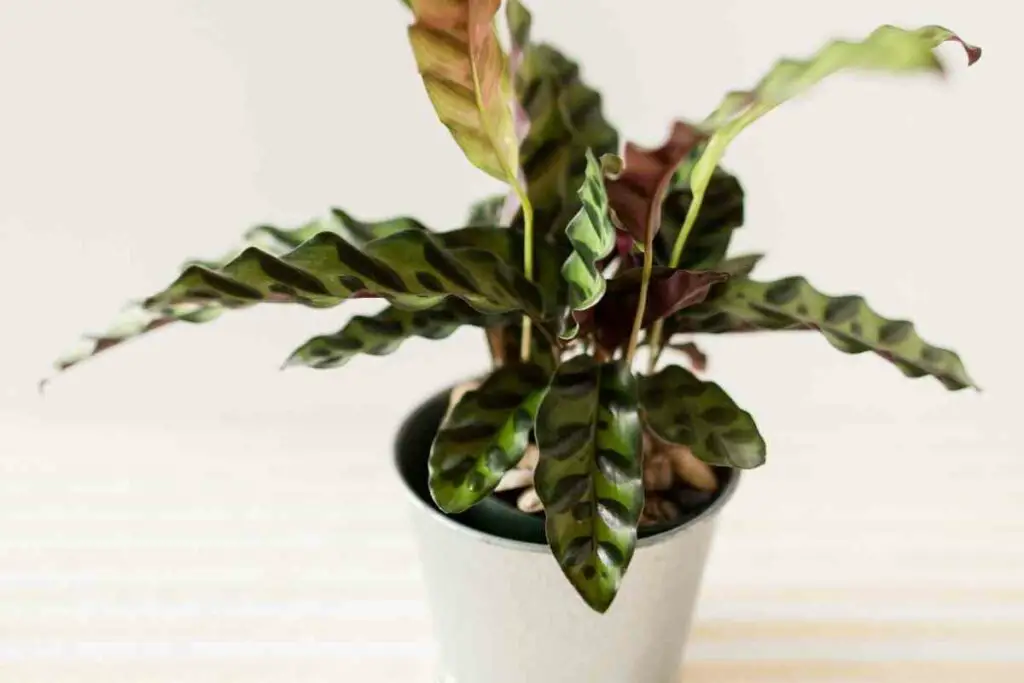There are many reasons why your Calathea rattlesnake leaves could be curling. Most of the time, curling leaves come from under-watering. You can help the plant by keeping the soil consistently moist and aerating the soil. This defensive mechanism indicates that something is wrong with the plant.
Changing your watering schedule is the best way to prevent Calathea leaves from curling.
You’ll need to determine whether you’re over or under watering that plant, then make the adjustments. It can take new gardeners a few tries to get it right.

Table of Contents
Why Are Calathea Leaves Curling?
Calathea Rattlesnakes leaves curl when they aren’t receiving enough water. However, they can curl when receiving too much. You’ll have to figure out how you’re watering them wrong first.
Calathea Rattlesnake plants are very picky. They can curl when they have issues with the water you’re giving them or even the temperature. You can try moving your Calathea plant to a warmer room and see if that helps at all
How To Figure Out Why Leaves Are Curling
There are a few different ways to determine why your Calathea leaves are curling. Start by touching the soil with your finger. You want to poke a hole up to your first knuckle to feel the inner layer of soil.
Suppose the soil feels dry; water the plant until the soil is moist again. Water should flow out of the irrigation holes at the bottom of the plant’s container.
Wait a few hours, then check on the plant again. The leaves should start uncurling if there is enough water.
You can usually tell that under watering is the problem if the leaves curl and turn brown and crispy on the edges. However, overwatering can be an issue if the leaves are curling but not dry.
You’ll want to check the soil. If it’s still wet, then poke several deep holes into it. These holes aerate the soil and can help dry the soil naturally.
Lastly, if the soil feels perfect, but the plant still has many curling leaves, it could be suffering from root rot. You’ll need to uproot the plant and inspect it.
You can treat root rot by washing the roots, trimming away the dying root sections, and replanting the Calathea.
What Does It Mean When Calathea Leaves Curl?
Calathea plants are very picky when it comes to their environment. Their leaves droop, curl, or turn yellow when the plant experiences stress. However, many different things can cause stress.
So, when you see curling leaves, you’ll want to know what it means. Changes to the leaves are a sign that something is going wrong with your plant, but you’ll need to figure out what it is.
Common causes of Calathea leaves changing include:
- Being placed in a draft
- Sudden temperature or light changes
- Over or under watering
- No aeration in the soil
- Root rot
- Change in location
- Over fertilizing or excessive compost
To summarize, curling leaves mean that the plant is unhappy with its situation. Once the plant gets used to its new surroundings, or you change your watering habits, it should uncurl and look healthy again.
If you don’t do anything, the plant could wilt! It’s best to take action when you notice the leaves are changing. Curling leaves are a defensive mechanism for Calatheas, so always help them.

What Can I Do To Uncurl Calathea Leaves?
Fixing the problem will help the plant thrive, causing the leaves to unfurl. You’ll want to try these quick fixes on your plant:
- Move the plant out of direct sunlight
- Keep the room’s temperature between 60 – 85°F
- Add more humidity to the room
- Water the calathea only when it needs it
- Use distilled water- not tap!
After going through this list, your plant is sure to look much healthier.
While Calathea leaves can quickly curl, dry up, or wilt, they’re also very responsive when they love their environment. They’ll perk up quickly!
Do Calathea Plants Like Direct Sunlight
One of the biggest mistakes new Calathea owners make is putting the plant in direct sunlight. These plants come from crowded rainforests, where they don’t naturally receive much light.
Direct sunshine will fade the leaves and cause them to curl. The plant does this to “hide” from the sun, so it doesn’t absorb as much of it.
If you put up a sheer curtain or move the plant a few feet away from the window, you should get great results!
Do Calathea Plants Need Humid and Consistent Temperatures
Calathea plants also dislike temperature extremes. They’ll curl their leaves in the cold to conserve heat. However, the leaves can quickly shrivel up if it’s too hot.
You’ll need to keep the temperature around the plant between 60 and 85°F. Watch how your plant reacts when you change the temperature. If they curl more, then turn the thermostat the other way.
Plus, you’ll need to work on the humidity levels in the home. Low humidity can cause the leaf to curl. The leaves absorb moisture from the air but tighten and turn brittle when they don’t get enough.
Gently misting the plant with a spray bottle can help temporarily. Still, you’ll likely want to use a humidifier in the room.
Prices pulled from the Amazon Product Advertising API on:
Product prices and availability are accurate as of the date/time indicated and are subject to change. Any price and availability information displayed on [relevant Amazon Site(s), as applicable] at the time of purchase will apply to the purchase of this product.
Change Your Watering Habits
Finally, you may need to change your watering habits. Calathea leaves curl when they don’t like the way you’ve been watering them.
While this usually has to do with over or under watering, the type of water you also use matters.
Calatheas don’t like tap water. It can contain too many minerals for them to process and chlorine and other chemicals. The leaves may turn yellow too.
Instead of tap water, try using distilled water. Some gardeners also collect water in a rain barrel on their Calatheas. Make sure the water is at room temperature before using it too.
In short, changing your watering habits can greatly impact the health of your Calathea plants. It’s easy to make these adjustments, so start as soon as possible.














